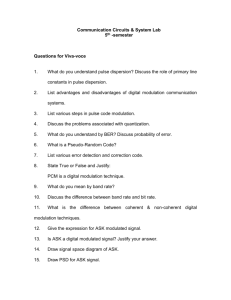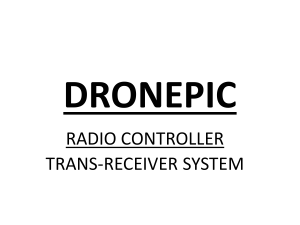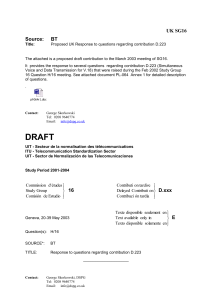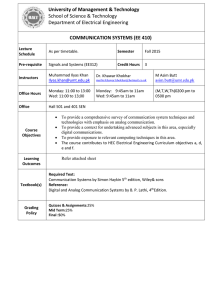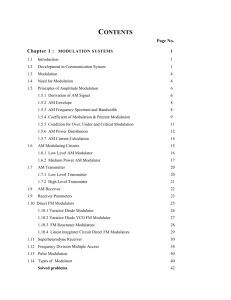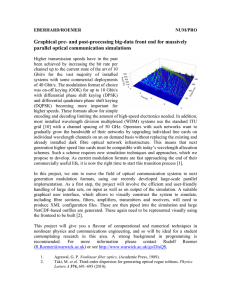Document 13135913
advertisement
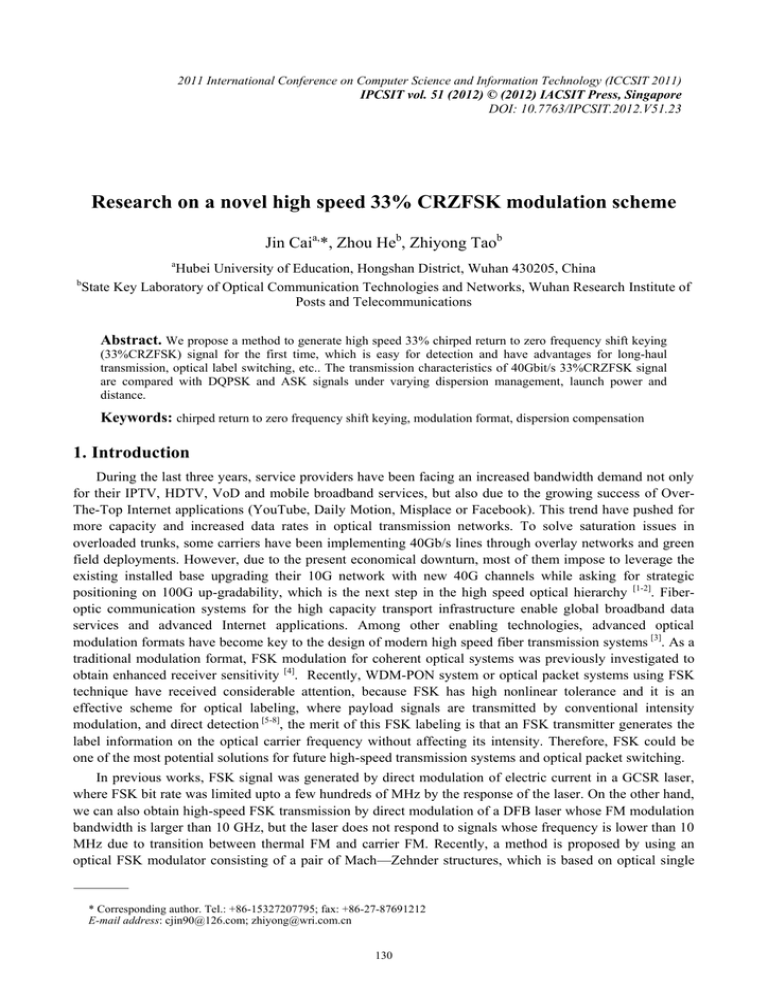
2011 International Conference on Computer Science and Information Technology (ICCSIT 2011) IPCSIT vol. 51 (2012) © (2012) IACSIT Press, Singapore DOI: 10.7763/IPCSIT.2012.V51.23 Research on a novel high speed 33% CRZFSK modulation scheme Jin Caia,*, Zhou Heb, Zhiyong Taob a b Hubei University of Education, Hongshan District, Wuhan 430205, China State Key Laboratory of Optical Communication Technologies and Networks, Wuhan Research Institute of Posts and Telecommunications Abstract. We propose a method to generate high speed 33% chirped return to zero frequency shift keying (33%CRZFSK) signal for the first time, which is easy for detection and have advantages for long-haul transmission, optical label switching, etc.. The transmission characteristics of 40Gbit/s 33%CRZFSK signal are compared with DQPSK and ASK signals under varying dispersion management, launch power and distance. Keywords: chirped return to zero frequency shift keying, modulation format, dispersion compensation 1. Introduction During the last three years, service providers have been facing an increased bandwidth demand not only for their IPTV, HDTV, VoD and mobile broadband services, but also due to the growing success of OverThe-Top Internet applications (YouTube, Daily Motion, Misplace or Facebook). This trend have pushed for more capacity and increased data rates in optical transmission networks. To solve saturation issues in overloaded trunks, some carriers have been implementing 40Gb/s lines through overlay networks and green field deployments. However, due to the present economical downturn, most of them impose to leverage the existing installed base upgrading their 10G network with new 40G channels while asking for strategic positioning on 100G up-gradability, which is the next step in the high speed optical hierarchy [1-2]. Fiberoptic communication systems for the high capacity transport infrastructure enable global broadband data services and advanced Internet applications. Among other enabling technologies, advanced optical modulation formats have become key to the design of modern high speed fiber transmission systems [3]. As a traditional modulation format, FSK modulation for coherent optical systems was previously investigated to obtain enhanced receiver sensitivity [4]. Recently, WDM-PON system or optical packet systems using FSK technique have received considerable attention, because FSK has high nonlinear tolerance and it is an effective scheme for optical labeling, where payload signals are transmitted by conventional intensity modulation, and direct detection [5-8], the merit of this FSK labeling is that an FSK transmitter generates the label information on the optical carrier frequency without affecting its intensity. Therefore, FSK could be one of the most potential solutions for future high-speed transmission systems and optical packet switching. In previous works, FSK signal was generated by direct modulation of electric current in a GCSR laser, where FSK bit rate was limited upto a few hundreds of MHz by the response of the laser. On the other hand, we can also obtain high-speed FSK transmission by direct modulation of a DFB laser whose FM modulation bandwidth is larger than 10 GHz, but the laser does not respond to signals whose frequency is lower than 10 MHz due to transition between thermal FM and carrier FM. Recently, a method is proposed by using an optical FSK modulator consisting of a pair of Mach—Zehnder structures, which is based on optical single * Corresponding author. Tel.: +86-15327207795; fax: +86-27-87691212 E-mail address: cjin90@126.com; zhiyong@wri.com.cn 130 sideband (SSB) modulation technique[4], but the just can realized 10Gb/s signals. A novel 40Gb/s 33%CRZFSK modulation format is investigated for the first time in this paper. 2. Principle Fig.1 shows the simulation setup of 40Gb/s 33%CRZ-FSK signal. The MZM1 is biased at the null of its transmission curve and differentially driven at twice the switching voltage with an ac-coupled sine wave at Hz (N=1,2,3,…, B is the bit rate). In this way the optical carrier is suppressed and two symmetrical beat modes are generated. These two modes are input to the phase modulator to undergo DPSK modulation, and then demodulated to intensity modulation by the subsequent MZDI. The center frequencies of the two beams are 193THz and 193.1THz so that one beam is at the maximum transmission of the MZDI while the other at the minimum (shown in the Fig.2). Therefore the demodulated data streams at the two wavelengths are identical but logically inverted. In this way, a FSK signal with constant optical power is generated [9]. Sinusoidally driving an MZM2 at half the data rate between its transmission minima produces a pulse whenever the drive voltage passes a transmission maximum, this way, duty cycles of 33% RZFSK can be realized. 33%CRZFSK signals are typically generated by sinusoidally modulating the phase of a 33%RZFSK signal at the data rate using a separate phase modulator. At the receiver, A Gaussian filter is used to filter out 33%CRZFSK one tone implementing the frequency discrimination, and demodulate the FSK into intensity modulation, and received by the traditional intensity modulation receiver. Transmission (dB) (2 N 1) B 4 NRZ XOR Tb (2N+1)/4Tb Clock clock CW1 Signal1 MZM1 Phase modulator Phase modulator MZDI Constructive interference Destructive interference 1/T b f1 MZM2 f2 FTS Frequency (Hz) Pulse carver Inverted data data Fig. 1. Schematics of the 33%CRZFSK transmitter. Fig. 2.Spectrum of the FSK two tones 3. Transmission performance We investigated transmission characteristics under varying fiber length consisting of standard single mode fiber (SMF) compensated by dispersion compensation fiber (DCF) for 33%CRZFSK (fig.4), ASK (fig.5), DQPSK (fig.6) signals. Hybrid- compensation Post-compensation DCF SMF EDFA DCF Pre-compensation EDFA FSK transmission Fig. 3. Transmission line of 40Gb/s 33%CRZ-FSK signal It can be seen from the fig.4-6 that, for 33%CRZFSK system under post compensation scheme, the optimum launch power is nearly 10dBm for the SMF length shorter than 80km, while ASK and DQPSK is 5dBm; it is 15dBm for longer than 80km while ASK and DQPSK is 10dBm. ASK, DQPSK signals degraded a lot while launch power is higher than 10dBm; for the same length 120Km, 33%CRZFSK shows the better Q value compared with ASK and DQPSK signal while the launch power is 15dBm, and has longer transmission distance. Simulation result (fig.7) shows that 33%CRZFSK has the best nonlinear tolerance. The relationships between received power and BER of different input power under post-compensation for 80km SMF transmission are demonstrated in Fig.8, it can be concluded that, the sensitivity became maximum and then gradually became small while increasing the input power. The sensitivity power is 18.5dBm for 33%CRZFSK signals and the launch power didn't have much effect on receiver sensitivity of the signals. 131 16 70 14 20 80 12 60 10 40 10 50 40 Q Q 15 60 20 8 5 0 20 launch power(dBm) 250 10 200 200 2 150 0 20 -20 20 4 250 10 30 0 6 -10 50 0 Fig. 4. 33%CRZFSK performance for postcompensation compensation scheme 100 -10 launch power(dBm) SMF length(km) 0 50 0 SMF length(km) Fig. 5. ASK performance for post-compensation compensation scheme 25 30 25 20 20 Q 10 150 0 100 15 15 10 5 10 0 20 5 250 10 200 150 0 launch power(dBm) 50 -10 100 SMF length(dBm) 0 Fig. 6. DQPSK performance for post-compensation compensation scheme 20 18 16 14 12 Q 10 8 6 4 33% CRZFSK ASK DQPSK 2 0 4 6 8 10 12 14 16 18 20 launch power(dBm) Fig. 7.Nonlinear tolerance comparison of different modulation formats 132 22 24 5 0 5dBm 10dBm 15dBm -5 -10 log(BER) -15 -20 -25 -30 -35 -40 -45 -50 -35 -30 -25 -20 -15 -10 -5 0 5 10 Received power(dBm) Fig. 8.Different input power for 33%CRZFSK as a function of received power and log(BER) 4. Conclusion A novel 33%CRZFSK transmitter that can operate at 40 Gb/s and above is proposed. We compared the nonlinear tolerance performance of 33%CRZFSK, DQPSK and ASK, studied the transmission performance of these signals at 40Gb/s under the post compensation schemes. Simulation results show that 33%CRZFSK modulation format has the best nonlinear tolerance performance and longest transmission distance for the same condition. It suggests that 33%CRZFSK modulation scheme could be a promising candidate for future high-speed transmission system and optical label switching networks. 5. References [1] “The road to 100Gbit/s transport networks”, Heavy Reading report, June 2009 [2] Jean-Paul Faure,et al, 40G and 100G deployment on 10G Infrastructure: market overview and trends, Coherent versus Conventional technology , in Proceedings of OFC/NFOEC 2010, Paper OThE3 [3] P. J. Winzer et al, Advanced Modulation Formats for High-Capacity Optical Transport Networks, J. of L.Tech., vol.. 24, No. 12, Dec. 2006 [4] Tetsuya Kawanishi, et al, High-speed optical DQPSK and FSK modulation using integrated Mach-Zehnder interferometers, OPTICS EXPRESS , 15 May 2006 ,Vol. 14, No. 10 / 4469. [5] Tetsuya Kawanishi,etal, High Speed Optical FSK Modulator for Optical Packet Labeling,Lightwave Technology, 2005,23(1):87~94. [6] Xiao Liu, etal, A Novel WDM-PON Structure Using the Orthogonal FSK/ASK Re-modulation Scheme , in Proceedings of OSA/ACP 2009, TuT5 [7] Fangfei Liu,etal, DPSK/FSK Hybrid Modulation Format and Analysis of Its Nonlinear performance, Journal of Lightwave Technology, VOL. 26, NO. 3, February 1, 2008 [8] Takahisa Fujita, etal, OOK/FSK WDM system using external optical FSK modulation, ECOC 2005 Proceedings ,VolA, Paper Th 1.2.5 [9] Zhou He, etal, Theoretical and experimental investigation on a 40Gb/s FSK transmission link, China Communications, April 2010, Vol.7, No.2: 92-99. 133
